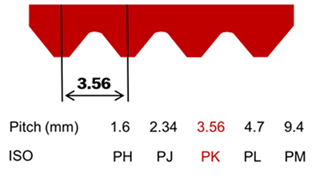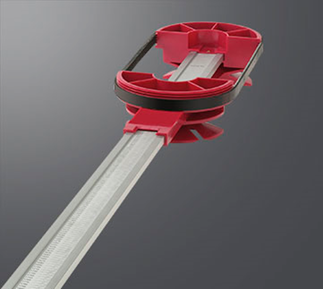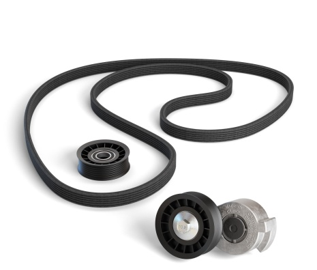With more than 1,300 Micro-V® belts in our catalogue, Gates’ belt range is the most complete in the market, covering over 96% of the European vehicle fleet that has a multi-ribbed belt in it. While this is obviously good news, selecting the right belts can be a challenge, given that all of them come with their own dimensions and characteristics. “Just rely on the belt that was mounted before”, you say? While a vehicle should indeed enter the workshop with the right belt, this is not always the case. In this article, we elaborate on the danger of mounting the same belt without thinking twice. In addition, we counter the common misunderstanding that a small difference in length between the OE (Original Equipment) belt and its aftermarket counterpart can cause belt failure.
The sizing of Micro-V® belts
1. Check the reference
A belt’s reference provides you with a lot of information about its key dimensions. Let’s take the belt that is mounted on more than a million vehicles as an example. The reference of this belt, 6PK1893, tells us:
• the number of ribs (6)
• the type of profile it has (PK)
• and what the nominal length of the belt is (1893)
But how about the belt width, length and thickness?
2. Belt width
The width of a belt depends on the profile and the number of ribs. The most-used profile in the automotive industry is the PK profile. This standardised profile has a width of 3.56 mm per rib (i.e. pitch):
3PK = 10.68 mm
4PK = 14.24 mm
5PK = 17.80 mm
6PK = 21.36 mm

3. Belt length
No aftermarket supplier manufactures an exact belt for each engine. Instead, belts with very similar dimensions are taken and grouped into a single belt that covers several OE lengths, provided that they do not exceed the tolerance of each engine. Slight differences in length do not negatively impact belt performance. After all, tolerances are common in the original belts too. Over time, belts tend to become somewhat longer, under the influence of wear and stretch.
Having a single belt cover several measures makes it unnecessary to manufacture a huge amount of references that would, in turn, become an abundance of stock. Indeed, producing exact matches for each OE belt would generate an unmanageable volume of belts for the aftermarket, which is not only inefficient but also unprofitable. In other words, Gates’ commitment to consolidation and to adjusting the number of references to market needs saves you precious warehouse space and avoids unnecessary investments.

4. Belt thickness
The
belt’s thickness cannot be derived from the reference. It depends on the design of the belt (whether it is a Gates Stretch Fit
™, Electro-Mechanical Drive or a Heavy-Duty Belt, to name just these). So, while the profile of a belt is standardised, the thickness is not. It may vary by supplier. To avoid choosing the wrong belt, always follow the Gates prescriptions, which you can find in
the catalogue.
Why you can’t rely on the belt that was mounted before
We cannot stress this enough: when installing a belt, do not rely on the one that is mounted before, especially if the customer reports noise problems. While it should be safe to assume that a vehicle that enters the workshop for maintenance comes with the correct belt, there are nevertheless some situations in which this may not be the case.
1. Attempts to solve (or rather, mask) noise issues
To
eliminate noise, some mechanics are in the habit of mounting the belt with the next smallest measure. Even though increasing the tension in the system can indeed eliminate noises, this is a stopgap rather than a solution. And not only does it not solve the problem, it can also create a more serious issue by subjecting the system to
excessive stress. A good way to ensure proper maintenance of the accessory belt and to avoid subsequent problems is to replace the belt together with the tensioner, the idler, the torsional vibration damper and the overrunning alternator pulley, using the
Micro-V® kit.

2. Brand-related differences
Secondly, the way a belt is named may vary from brand to brand. In the case of Stretch Fit™ Belts, for instance, Gates establishes the reference of the belt according to the OE nomenclature, while other brands may name the belt relying on the size when installed, and there may be a significant difference between both references.
3. Same length, different type
Finally, a belt that has the same length but belongs to another type (e.g.
EMD, SF, XS or HD) should not be mounted, since each type of belt has its own characteristics and build, adapted to the requirements of the engine design. For example, despite being apparently the same, the 5PK1665 is constructed differently from the 5PK1665XS, so they are
not interchangeable.
So, what should you do?
To be safe, ask your usual spare parts store for the vehicle data or consult the
Gates catalogue. Gates makes sure the prescribed belt falls within close tolerances of the original dimensions and is at least as powerful and versatile as the original belt. In addition, don’t be misled by the common perception that
a small difference in length may cause belt failure. The real causes range from incorrect belt tension to a poorly aligned belt or to other worn components in the system.
Want to know more about our full range of belts? Feel free to visit our blog.